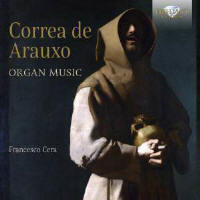Texte paru dans: / Appeared in: |
|
|
Outil de traduction ~ (Très approximatif) |
|
|
Reviewer: James
A. Altena
Francisco Correa de Arauxo
(1584–1654)—also spelled “Araujo” and “Azavedo”—led a somewhat difficult
life, possibly because he seems to have been a somewhat difficult man. He
was apparently of Portuguese origin, and may have studied in Seville with
Francisco de Peraza (1564–1598); he later stated that he studied the works
of that master and of Diego del Castillo (1544–1601). In 1599 he was
appointed the organist of the Church of San Salvador in Seville, though a
lawsuit over the position with a rival hindered him from assuming the
position for another six years. His exceptional skills soon led to him being
awarded a salary more than twice that of the maestro de capilla, and in 1608
he was ordained a priest. His fortunes seemed to have peaked in 1626, when
he was appointed to a lucrative chaplaincy and titled a licentiate in
theology, and also published his only surviving collection of compositions,
the Libro de tientos y discursos de música practica, y theorica de organo
intitulado Facultad organica (Book of tientos and discourses of
practical music, and theory of the organ, titled “Organic Faculty”). After
that, his fortunes declined precipitously. In 1630 he became embroiled in
lawsuits when he led a revolt of musicians against being forced to perform
additional duties without correspondingly increased pay, and was imprisoned
for insubordination and conduct unbecoming a priest. By 1635 his health had
declined to a point where he was regularly receiving sick pay; despite his
considerable income he was also chronically in financial straits. In 1637,
ill and unhappy, he left Seville to become organist of the cathedral church
of the Assumption of the Virgin in Jaén, but left there after only three
years to become an organist and prebendary at the Segovia cathedral. There
his health and finances worsened until, after a long illness, he died in
poverty. The Facultad organica, as it is generally known, is considered one of the most important keyboard collections to emerge from 17th-century Spain. It contains 69 pieces of music, 62 of those being tientos (the Spanish counterpart to the English fantasy and Italian ricercar), arranged in order of increasing difficulty. (The other seven works are two intabulations, two cantus firmus settings, and three sets of variations.) The discursos (an unusual musical borrowing of a term from classical rhetoric) are tientos of greater complexity, requiring more advanced technique to perform, with the most complex works showing advances over those of Cabezón. The Facultad organica is also a theoretical treatise that treats such matters as tablatures, fingerings, key signatures (rudimentary at that time), dissonances (including the playing of a note simultaneously in its normal and chromatically altered forms), complex rhythmic patterns, ornamentations (glosas), and the medio registro (the divided keyboard, unique to Spanish organs, that uses different sets of pipes for different halves of a single keyboard). This disc presents 19 of those 69 works. The organ used, a very small instrument in the church of Santa Maria in Garrovillas de Alconétar, dates from c. 1550. Restored in 1990, it is believed to be the oldest working organ in Spain; it has one keyboard and no pedalboard, only nine stops, and is tuned to 1/4 comma mean-tone temperament at 1 1/5 tones above 440 Hz (again an unusual feature of some Spanish organs). Obviously, the sound is absolutely authentic, and Francesco Cera has the style completely in hand. The proceedings are well recorded (not that cathedral-like reverberations of a full-sized organ are an issue here), and the booklet provides detailed notes, an artist bio, instrumental specifications, and color photos. One only wishes that Brilliant had sprung for recording the entire book instead of less than a third of it. Correa de Arauxo’s music remains a rarity on disc. I can locate only a few previous recordings on CD (there are a couple of LP releases): a 1990 Ricercar issue with Bernard Foccroulle (on a very inauthentic-sounding French organ); a 1992 Erato disc, recently reissued in Japan, with Odile Bailleux (played on a very tangy French Baroque organ); a 2004 release with Andres Cea on Lindoro (fine performances on a somewhat larger instrument); a 2011 disc by Paraty with Louis Thiry (reviewed by J. F. Weber in 36:4, who was more enthusiastic for it than I am); and a five-CD set of the complete Facultad organica with Robert Bates (performed on three historic 18th-century organs in Mexico and two modern instruments in California, all considerably more powerful than the one employed here). A previous complete edition on Almaviva from 1996 by José Enrique Ayarra (preferable to the Loft version in its choice of instruments, to my ears) is long out of print but available as a download. Unless you already know and love this music, and wish to spring for one of the two complete editions, this new super-budget Brilliant release is clearly the way to go for an entrée into Correa de Arauxo’s oeuvre; cordially recommended. | |
|
|
|
|
Cliquez l'un ou l'autre
bouton pour découvrir bien d'autres critiques de CD |
|




